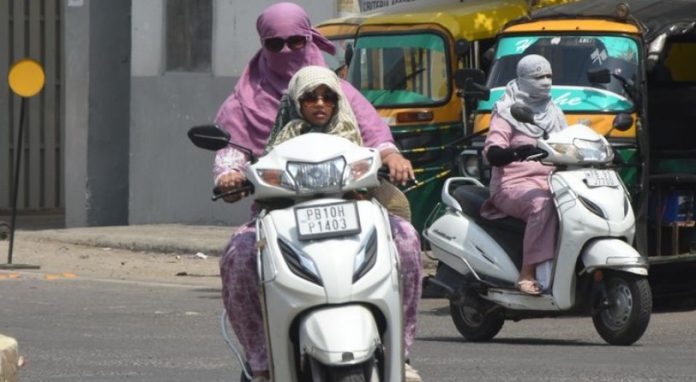As the relentless sun continues its scorching assault, painting the Ludhiana sky with an unforgiving brilliance, local authorities and public health officials have issued a unified and urgent plea to all residents: a simple yet vital directive to drink copious amounts of water and to seek immediate shelter indoors during the intensely hot afternoon hours. This critical guidance arrives as the region finds itself firmly gripped by a burgeoning heatwave, a severe and potentially life-threatening weather phenomenon that poses profound health risks, especially to the city’s most vulnerable inhabitants. This unequivocal instruction is not merely a suggestion, but a proactive measure meticulously designed to mitigate the perilous potential for heatstroke, severe dehydration, and a spectrum of other heat-related illnesses that can rapidly escalate into dire medical emergencies under such extreme climatic conditions.
The mercury’s unwavering ascent has seen temperatures consistently hover around the distressing 40-degree Celsius mark, with grim projections from the local meteorological department indicating an even further escalation in the coming days, offering little promise of immediate respite from the oppressive heat. This sustained period of exceptionally high temperatures necessitates a collective and immediate shift in daily routines, demanding an enhanced awareness of personal well-being and a proactive approach to safeguarding one’s health. The city, accustomed to its warm summers, is now facing a period of unusual and dangerous intensity, requiring every resident to exercise heightened caution and adhere strictly to preventive measures.
A heatwave is far more than just a period of uncomfortable warmth; it constitutes a profound and insidious public health threat. Prolonged and unmitigated exposure to these dangerously high temperatures, particularly when compounded by elevated humidity levels, can rapidly overwhelm the human body’s intricate and finely tuned natural cooling mechanisms. When the body struggles or fails to effectively regulate its internal temperature, it initiates a perilous cascade of heat-related illnesses. This spectrum of conditions ranges from the relatively milder, though still painful, heat cramps and the debilitating exhaustion brought on by heat, all the way to the life-threatening and critically urgent medical condition known as heatstroke.
Heatstroke represents the apex of heat-related illnesses and is a true medical emergency demanding immediate intervention. It occurs when the body’s core temperature breaches a critical threshold, rapidly ascending to 104°F (40°C) or even higher. The tell-tale symptoms are diverse and severe, often including a profound state of confusion, a visibly altered mental state, slurred or incoherent speech, and a potential loss of consciousness. The skin may feel alarmingly hot and dry to the touch, though in some instances, profuse sweating can still occur. Other ominous signs include uncontrollable seizures and a rapid, bounding pulse. Without swift and decisive medical attention, heatstroke carries a grave prognosis, often leading to permanent disability or, tragically, even death.

Beyond this critical emergency, other less severe but still debilitating conditions demand attention. Heat exhaustion manifests through symptoms such as heavy and excessive sweating, a pervasive sense of weakness or profound fatigue, skin that feels cold and clammy, painful muscle cramps, an unsettling dizziness, persistent headaches, and an unpleasant nausea. Heat cramps, while less severe, are characterized by sudden and intensely painful muscle spasms, most commonly affecting the legs or abdomen, and typically occur during periods of strenuous physical activity undertaken in hot environments. Finally, dehydration, a dangerous and often insidious reduction in the body’s vital water content, can lead to widespread fatigue, dizziness, impaired cognitive function, and a general compromise of various bodily systems.
Certain segments of the population are particularly vulnerable and face a significantly elevated risk during periods of intense heatwaves. This includes infants and very young children, whose underdeveloped bodies are less efficient at regulating temperature; the elderly, who may contend with underlying chronic health conditions or be taking medications that inadvertently impair their body’s ability to cope with extreme heat; individuals afflicted with pre-existing chronic medical conditions such as serious heart disease, diabetes, or debilitating respiratory illnesses; and crucially, outdoor workers, including construction laborers, agricultural workers, and street vendors, who are relentlessly exposed to direct sunlight and oppressive temperatures for prolonged durations without adequate respite.
The core tenets of the current advisory, issued with utmost urgency, unequivocally revolve around two fundamental and indispensable preventive measures: aggressive and consistent hydration, and the paramount importance of seeking appropriate shelter during the sun’s most intense period.
Drinking ample amounts of water is not merely advised, but rather constitutes a non-negotiable imperative. Residents are strongly urged to consume water systematically and consistently throughout the day, irrespective of whether they perceive themselves to be thirsty. The sensation of thirst is often a delayed indicator, signaling that the body has already initiated the process of dehydration. Beyond plain water, other beneficial fluids include fresh fruit juices, traditional buttermilk (chaas), and readily available oral rehydration solutions (ORS), which are particularly effective in replenishing electrolytes. Conversely, sugary drinks, caffeinated beverages, and alcoholic concoctions should be scrupulously avoided, as they possess diuretic properties that can paradoxically lead to further and more severe dehydration. Maintaining a personal water bottle within easy reach and taking frequent sips, even during brief excursions outdoors, is an absolutely crucial habit to cultivate.
Staying indoors during the peak afternoon hours is equally, if not more, vital. The period typically spanning between 12 PM and 4 PM represents the zenith of the sun’s intensity and the apex of daily temperatures. During these critically dangerous hours, direct exposure to sunlight must be minimized to the greatest extent possible. If venturing outside becomes an absolute necessity, individuals are strongly advised to meticulously cover their heads with a wide-brimmed cap or carry an umbrella, don loose-fitting, light-colored cotton clothing that promotes air circulation, and, crucially, always carry a sufficient supply of water. All non-essential outdoor activities, strenuous errands, or any form of physical labor should be judiciously planned for the significantly cooler parts of the day – ideally, the early morning hours or the late evening, once the sun’s intensity has considerably waned.
Beyond these core directives, the authorities have diligently reiterated several other practical and essential steps that residents can adopt to further enhance their personal safety and collective well-being during this hazardous period:
Choose appropriate clothing: Prioritize lightweight, loosely fitted, and light-colored attire crafted from breathable natural fabrics such as cotton. Such clothing effectively reflects sunlight and facilitates essential air circulation, thereby aiding the body’s natural cooling processes.
Utilize cooling aids: Incorporate regular cool showers or baths into your daily routine. Applying cool, damp towels to the skin or immersing feet in cool water can also significantly help in lowering the body’s core temperature.
Abstain from strenuous outdoor activities: Strictly avoid any form of intense physical exertion or strenuous labor during the hottest segments of the day. If outdoor exercise is deemed absolutely necessary, it should be confined to the very early morning or late evening hours when temperatures are considerably lower.
Conduct welfare checks on vulnerable individuals: Make a conscious effort to regularly check on neighbors, elderly relatives, and individuals residing alone, ensuring they are coping effectively with the heat and have ready access to necessary hydration and cooling resources.
Ensure the safety of pets and livestock: Animals are equally susceptible to heat stress and require diligent care. Always ensure that pets have ample access to shaded areas and a continuous supply of fresh, clean water.
Acquaint yourself with symptoms of heat-related illness: Remain vigilant and be acutely aware of the warning signs of heat exhaustion and, more critically, heatstroke. If anyone exhibits these symptoms, immediately move them to a cooler environment, apply cool compresses to their body, and seek prompt medical attention, especially if symptoms worsen or include confusion or loss of consciousness.
Minimize indoor heat generation: During the hottest parts of the day, consciously limit the use of heat-generating appliances such as ovens, clothes dryers, and dishwashers. Utilize curtains or blinds to effectively block direct sunlight from entering indoor spaces, thereby helping to maintain cooler ambient temperatures.
The current heatwave blanketing Ludhiana represents a serious and immediate public health concern. By adhering strictly and diligently to the clear advice of consuming ample amounts of water and consistently seeking refuge indoors during the peak afternoon hours, every resident can significantly diminish their individual risk of succumbing to heat-related illnesses. The collective effort and unwavering individual vigilance will prove absolutely crucial in safely navigating this challenging period of extreme temperatures. Stay safe, stay hydrated, and stay cool, Ludhiana.


